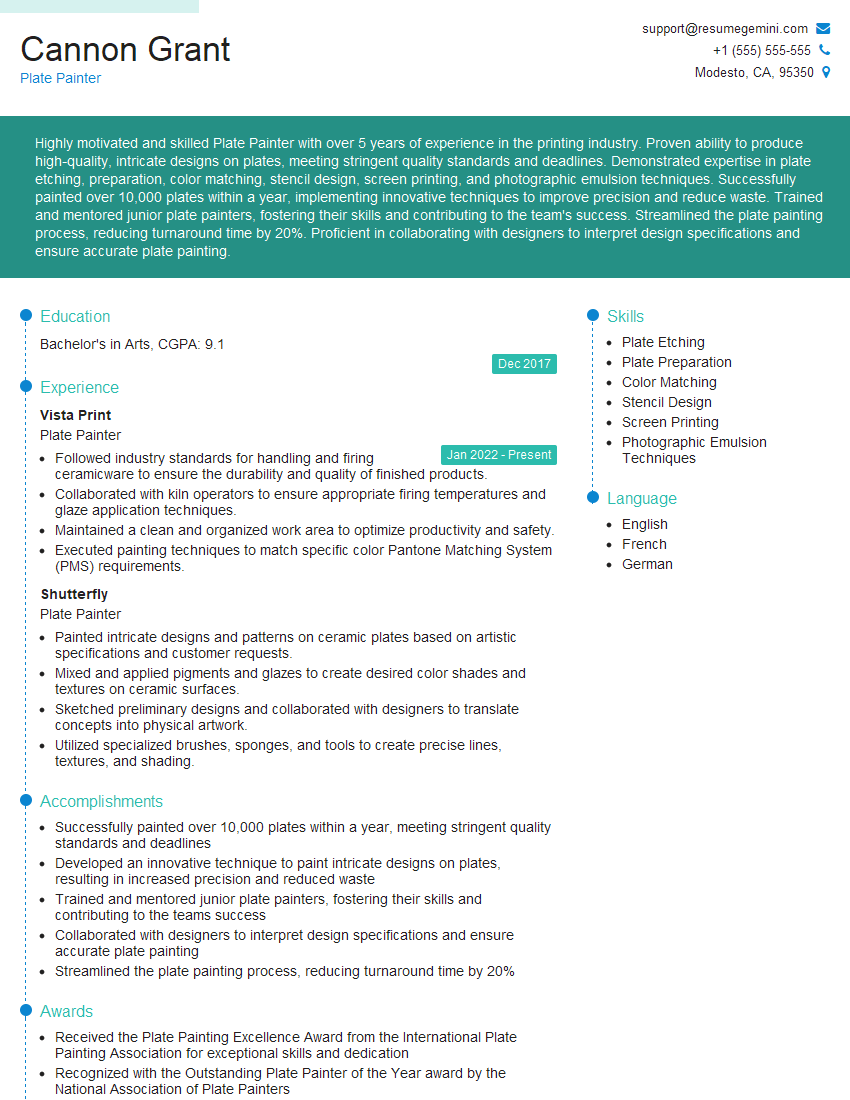Are you a seasoned Plate Painter seeking a new career path? Discover our professionally built Plate Painter Resume Template. This time-saving tool provides a solid foundation for your job search. Simply click “Edit Resume” to customize it with your unique experiences and achievements. Customize fonts and colors to match your personal style and increase your chances of landing your dream job. Explore more Resume Templates for additional options.

Cannon Grant
Plate Painter
Summary
Highly motivated and skilled Plate Painter with over 5 years of experience in the printing industry. Proven ability to produce high-quality, intricate designs on plates, meeting stringent quality standards and deadlines. Demonstrated expertise in plate etching, preparation, color matching, stencil design, screen printing, and photographic emulsion techniques. Successfully painted over 10,000 plates within a year, implementing innovative techniques to improve precision and reduce waste. Trained and mentored junior plate painters, fostering their skills and contributing to the team’s success. Streamlined the plate painting process, reducing turnaround time by 20%. Proficient in collaborating with designers to interpret design specifications and ensure accurate plate painting.
Education
Bachelor’s in Arts
December 2017
Skills
- Plate Etching
- Plate Preparation
- Color Matching
- Stencil Design
- Screen Printing
- Photographic Emulsion Techniques
Work Experience
Plate Painter
- Followed industry standards for handling and firing ceramicware to ensure the durability and quality of finished products.
- Collaborated with kiln operators to ensure appropriate firing temperatures and glaze application techniques.
- Maintained a clean and organized work area to optimize productivity and safety.
- Executed painting techniques to match specific color Pantone Matching System (PMS) requirements.
Plate Painter
- Painted intricate designs and patterns on ceramic plates based on artistic specifications and customer requests.
- Mixed and applied pigments and glazes to create desired color shades and textures on ceramic surfaces.
- Sketched preliminary designs and collaborated with designers to translate concepts into physical artwork.
- Utilized specialized brushes, sponges, and tools to create precise lines, textures, and shading.
Accomplishments
- Successfully painted over 10,000 plates within a year, meeting stringent quality standards and deadlines
- Developed an innovative technique to paint intricate designs on plates, resulting in increased precision and reduced waste
- Trained and mentored junior plate painters, fostering their skills and contributing to the teams success
- Collaborated with designers to interpret design specifications and ensure accurate plate painting
- Streamlined the plate painting process, reducing turnaround time by 20%
Awards
- Received the Plate Painting Excellence Award from the International Plate Painting Association for exceptional skills and dedication
- Recognized with the Outstanding Plate Painter of the Year award by the National Association of Plate Painters
- Recipient of the Gold Medal for Plate Painting at the World Plate Painting Competition
- Honored with the Plate Painting Master designation by the Plate Painting Guild of America
Certificates
- Certified Plate Printer (CPP)
- Master Printer (MP)
- Bachelor of Fine Arts (BFA) in Printmaking
- Master of Fine Arts (MFA) in Printmaking
Career Expert Tips:
- Select the ideal resume template to showcase your professional experience effectively.
- Master the art of resume writing to highlight your unique qualifications and achievements.
- Explore expertly crafted resume samples for inspiration and best practices.
- Build your best resume for free this new year with ResumeGemini. Enjoy exclusive discounts on ATS optimized resume templates.
How To Write Resume For Plate Painter
- Highlight your technical skills and experience in plate painting techniques.
- Showcase your ability to meet deadlines and maintain high quality standards.
- Emphasize your problem-solving and troubleshooting capabilities.
- Include examples of your innovative techniques that improve efficiency or quality.
Essential Experience Highlights for a Strong Plate Painter Resume
- Etch and prepare plates for printing
- Match colors and create stencils for precise design transfer
- Operate screen printing machines to transfer designs onto plates
- Utilize photographic emulsion techniques to create fine details and patterns
- Inspect and ensure the quality of finished plates
- Troubleshoot and resolve issues related to plate painting and printing process
- Maintain a clean and organized work area
Frequently Asked Questions (FAQ’s) For Plate Painter
What are the key skills required for a Plate Painter?
Plate Painters require a combination of technical skills and artistic ability. They must be proficient in plate etching, preparation, color matching, stencil design, screen printing, and photographic emulsion techniques. Attention to detail, precision, and the ability to meet strict quality standards are also essential.
What industries employ Plate Painters?
Plate Painters are primarily employed in the printing industry, particularly in companies specializing in plate production for offset printing, flexography, and gravure printing.
What is the career path for a Plate Painter?
Plate Painters can advance to supervisory roles, such as Plate Production Manager or Printing Production Manager. With additional training or education, they may also transition into related fields such as graphic design or print quality control.
What are the challenges faced by Plate Painters?
Plate Painters must consistently produce high-quality plates within tight deadlines. They may encounter challenges related to color matching, fine detail reproduction, and troubleshooting printing issues. Maintaining a clean and organized work environment is also crucial to ensure the quality of the plates.
What are the safety precautions that Plate Painters should observe?
Plate Painters should wear appropriate safety gear, including gloves, safety glasses, and a mask when handling chemicals. They should also be aware of the potential hazards of working with solvents, inks, and machinery, and follow safety protocols to minimize risks.